Experimental Proof of Concept for Using Hybrid Paper Based on Silver Nanowires, Cellulose and Poly(dimethylsiloxane) in Systems Dynamic Analysis and Healthcare Applications
Abstract
:1. Introduction
2. Materials and Methods
2.1. Chemicals and Materials
2.2. Characterization of Materials
2.3. Preparation of Silver Nanowires
2.4. Preparation of Sensor
2.5. Testing of Fabricated Sensors
3. Results and Discussion
3.1. Characterization of the Synthesized Silver Nanowires
3.2. Test Results with Hybrid Paper-Based Sensors
4. Conclusions
Author Contributions
Funding
Institutional Review Board Statement
Informed Consent Statement
Data Availability Statement
Acknowledgments
Conflicts of Interest
References
- Zhao, L.; Qiao, J.; Li, F.; Yuan, D.; Huang, J.; Wang, M.; Xu, S. Laser-patterned hierarchical aligned micro-/nanowire network for highly sensitive multidimensional strain sensor. ACS Appl. Mater. Interfaces 2022, 14, 48276–48284. [Google Scholar] [CrossRef] [PubMed]
- Hu, T.; Xuan, S.; Ding, L.; Gong, X. Stretchable and magneto-sensitive strain sensor based on silver nanowire-polyurethane sponge enhanced magnetorheological elastomer. Mater. Des. 2018, 156, 528–537. [Google Scholar] [CrossRef]
- Kim, K.H.; Jang, N.S.; Ha, S.H.; Cho, J.H.; Kim, J.M. Highly sensitive and stretchable resistive strain sensors based on microstructured metal nanowire/elastomer composite films. Small 2018, 14, 1704232. [Google Scholar] [CrossRef] [PubMed]
- Li, W.; He, Y.; Xu, J.; Wang, W.; Zhu, Z.; Liu, H. Preparation of Ag NWs and Ag NWs@PDMS stretchable sensors based on rapid polyol method and semi-dry process. J. Alloys Comp. 2019, 803, 332–340. [Google Scholar] [CrossRef]
- Wang, Y.; Chen, Q.; Zhang, G.; Xiao, C.; Wei, Y.; Li, W. Ultrathin flexible transparent composite electrode via semiembedding silver nanowires in a colorless polyimide for high performance ultraflexible organic solar cells. ACS Appl. Mater. Interfaces 2022, 14, 5699–5708. [Google Scholar] [CrossRef]
- Repon, R.; Mikucioniene, D. Progress in flexible electronic textile for heating application: A critical review. Materials 2021, 14, 6540. [Google Scholar] [CrossRef]
- Dong, X.; Wei, Y.; Chen, S.; Lin, Y.; Liu, L.; Li, Y. A linear and large-range pressure sensor based on a graphene/silver nanowires nanobiocomposites network and a hierarchical structural sponge. Compos. Sci. Technol. 2018, 155, 108–116. [Google Scholar] [CrossRef]
- Kwon, Y.B.; Kim, J.H.; Kim, Y.K. Efficient protection of silver nanowire transparent electrodes by all-biorenewable layer-by-layer assembled thin films. ACS Appl. Mater. Interfaces 2022, 14, 25993–26003. [Google Scholar] [CrossRef]
- Teodoro, K.B.R.; Sanfelice, R.C.; Migliorini, F.L.; Pavinatto, A.; Facure, M.H.M.; Correa, D.S. A review on the role and performance of cellulose nanomaterials in sensors. ACS Sens. 2021, 6, 2473–2496. [Google Scholar] [CrossRef] [PubMed]
- Zhu, M.; Yan, X.; Lei, Y.; Guo, J.; Xu, Y.; Xu, H.; Dai, L.; Kong, L. An ultrastrong and antibacterial silver nanowire/aligned cellulose scaffold composite film for electromagnetic interference shielding. ACS Appl. Mater. Interfaces 2022, 14, 14520–14531. [Google Scholar] [CrossRef]
- Han, M.; Shen, W.; Tong, X.; Corriou, J.P. Cellulose nanofiber/MXene/AgNWs composite nanopaper with mechanical robustness for high-performance humidity sensor and smart actuator. Sens. Actuators B Chem. 2024, 406, 135375. [Google Scholar] [CrossRef]
- Koga, H.; Nogi, M.; Komoda, N.; Nge, T.T.; Sugahara, T.; Suganuma, K. Uniformly connected conductive networks on cellulose nanofiber paper for transparent paper electronics. NPG Asia Mater. 2014, 6, e93. [Google Scholar] [CrossRef]
- Shobin, L.R.; Manivannan, S. Silver nanowires-single walled carbon nanotubes heterostructure chemiresistors. Sens. Actuators B 2018, 256, 7–17. [Google Scholar] [CrossRef]
- Chen, Y.C.; Hsu, J.H.; Lin, Y.G.; Hsu, Y.K. Silver nanowires on coffee filter as dual-sensing functionality for efficient and low-cost SERS substrate and electrochemical detection. Sens. Actuators B 2017, 245, 189–195. [Google Scholar] [CrossRef]
- Raman, S.; Arunagirinathan, R.S. Silver nanowires in stretchable resistive strain sensors. Nanomaterials 2022, 12, 1932. [Google Scholar] [CrossRef]
- Li, Z.; Chang, S.; Khuje, S.; Ren, S. Recent advancement of emerging nano copper-based printable flexible hybrid electronics. ACS Nano 2021, 15, 6211–6232. [Google Scholar] [CrossRef]
- Kang, K.; Lin, M.F.; Chen, J.; Lee, P.S. Highly transparent conducting nanopaper for solid state foldable electrochromic devices. Small 2016, 12, 6370–6377. [Google Scholar] [CrossRef] [PubMed]
- Ferrero, G.A.; Sevilla, M.; Fuertes, A.B. Free-standing hybrid films based on graphene and porous carbon particles for flexible supercapacitors. Sust. Energy Fuels 2017, 1, 127–137. [Google Scholar] [CrossRef]
- Yang, S.; Qian, X. Conductive PPy@cellulosic paper hybrid electrodes with a redox active dopant for high capacitance and cycling stability. Polymers 2022, 14, 2634. [Google Scholar] [CrossRef]
- Köwitsch, A.; Zhou, G.; Growth, T. Medical application of glycosaminoglycans: A review. J. Tissue Eng. Regen. Med. 2017, 12, 23–41. [Google Scholar] [CrossRef]
- Gao, G.; Edgar, K.J. Efficient synthesis of glycosaminoglycan analogs. Biomacromolecules 2019, 20, 608–617. [Google Scholar] [CrossRef] [PubMed]
- Cao, Y.; Lai, T.; Teng, F.; Liu, C.; Li, A. Highly stretchable and sensitive strain sensor based on silver nanowires/carbon nanotubes on hair band for human motion detection. Prog. Nat. Sci. Mat. Int. 2021, 31, 379–386. [Google Scholar] [CrossRef]
- Choi, H.Y.; Lee, T.W.; Lee, S.E.; Lim, J.D.; Leong, Y.G. Silver nanowire/carbon nanotube/cellulose hybrid papers for electrically conductive and electromagnetic interference shielding elements. Compos. Sci. Technol. 2017, 150, 45–53. [Google Scholar] [CrossRef]
- Huang, L.; Jiang, P.; Wang, D.; Luo, Y.; Li, M.; Lee, H.; Gerhardt, R.A. A novel paper-based flexible ammonia gas sensor via silver and SWNT-PABS inkjet printing. Sens. Actuators B 2014, 197, 308–313. [Google Scholar] [CrossRef]
- Yao, S.; Cui, J.; Cui, Z.; Zhu, Y. Soft electrothermal actuators using silver nanowire heaters. Nanoscale 2017, 9, 3797–3805. [Google Scholar] [CrossRef] [PubMed]
- Barras, R.; Cunha, I.; Gaspar, D.; Fortunato, E.; Martins, R.; Pereira, L. Printable cellulose-based electroconductive composites for sensing elements in paper electronics. Flex. Print. Electron. 2017, 2, 014006. [Google Scholar] [CrossRef]
- Cheng, R.; Wang, B.; Zeng, J.; Li, J.; Xu, J.; Gao, W.; Chen, K. High-performance and rapid-response electrical heaters derived from cellulose nanofiber/silver nanowire nanopapers for portable thermal management. ACS Appl. Mater. Interfaces 2022, 14, 30144–30159. [Google Scholar] [CrossRef]
- Bańbuła, S.; Domagała, N.; Ratajczak, M.; Kunert, M.; Ignaszewska, A.; Dzido, G.; Piotrowski, K.; Sakiewicz, P. Experimental proof-of-concept application of a triboelectric nanogenerator using a single polymer composite electrode for monitoring environmental factors. In Proceedings of the Contemporary Environmental and Energy Problems, Gliwice, Poland, 18–21 September 2023. in press. [Google Scholar]
- Tai, T.; Duan, Z.; Wang, Y.; Wang, S.; Jiang, Y. Paper-based sensors for gas, humidity, and strain detections: A review. ACS Appl. Mater. Interfaces 2020, 12, 31037–31053. [Google Scholar] [CrossRef]
- Betker, M.; Harder, C.; Erbes, E.; Heger, J.E.; Alexakis, A.E.; Sochor, B.; Chen, Q.; Schwartzkopf, M.; Körstgens, V.; Müller-Buschbaum, P.; et al. Sprayed hybrid cellulose nanofibril−silver nanowire transparent electrodes for organic electronic applications. ACS Appl. Nano Mater. 2023, 6, 13677–13688. [Google Scholar] [CrossRef]
- Cheng, R.; Zeng, J.; Wang, B.; Li, J.; Cheng, Z.; Xu, J.; Gao, W.; Chen, K. Ultralight, flexible and conductive silver nanowire/nanofibrillated cellulose aerogel for multifunctional strain sensor. Chem. Eng. J. 2021, 424, 130565. [Google Scholar] [CrossRef]
- Yin, R.; Yang, S.; Li, Q.; Zhang, S.; Liu, H.; Han, J.; Liu, C. Flexible conductive Ag nanowire/cellulose nanofibril hybrid nanopaper for strain and temperature sensing applications. Sci. Bull. 2020, 65, 899–908. [Google Scholar] [CrossRef] [PubMed]
- Guan, F.; Xie, Y.; Wu, H.; Meng, Y.; Shi, Y.; Gao, M.; Zhang, Z.; Chen, S.; Chen, Y.; Wang, H.; et al. Silver nanowire−bacterial cellulose composite fiber-based sensor for highly sensitive detection of pressure and proximity. ACS Nano 2020, 14, 15428–15439. [Google Scholar] [CrossRef] [PubMed]
- Han, J.W.; Prameswati, A.; Entifar, S.A.N.; Kim, J.H.; Wibowo, A.F.; Park, J.; Lee, J.; Kim, S.; Lim, D.C.; Moon, M.W.; et al. Highly conductive, flexible, and robust silver nanowire-embedded carboxymethyl cellulose/poly(3,4-ethylenedioxythiophene):poly(styrenesulfonate) composite films for wearable heaters and on-skin sensors. Electron. Mat. Lett. 2022, 18, 532–539. [Google Scholar] [CrossRef]
- Kumar, K.S.; Zhang, L.; Kalairaj, M.S.; Banerjee, H.; Xiao, X.; Jiayi, C.C.; Huang, H.; Lim, C.M.; Ouyang, J.; Ren, H. Stretchable and sensitive silver nanowire-hydrogel strain sensors for proprioceptive actuation. ACS Appl. Mater. Interfaces 2021, 13, 37816–37829. [Google Scholar] [CrossRef] [PubMed]
- Dzido, G.; Smolska, A.; Farooq, M.O. Rapid synthesis of silver nanowires in the polyol process with conventional and microwave heating. Appl. Sci. 2023, 13, 4963. [Google Scholar] [CrossRef]
- Wiley, B.; Sun, Y.; Xia, Y. Polyol synthesis of silver nanostructures: Control of product morphology with Fe(II) or Fe(III) species. Langmuir 2005, 21, 8078–8080. [Google Scholar] [CrossRef]
- Luu, Q.N.; Doorn, J.M.; Berry, M.T.; Jiang, C.; Lin, C.; May, P.S. Preparation and optical properties of silver nanowires and silver-nanowire thin films. J. Colloid Interface Sci. 2011, 356, 151–158. [Google Scholar] [CrossRef]
- Mao, H.; Feng, J.; Ma, X.; Wu, C.; Zhao, X. One-dimensional silver nanowires synthesized by self-seeding polyol process. J. Nanopart. Res. 2012, 14, 887. [Google Scholar] [CrossRef]
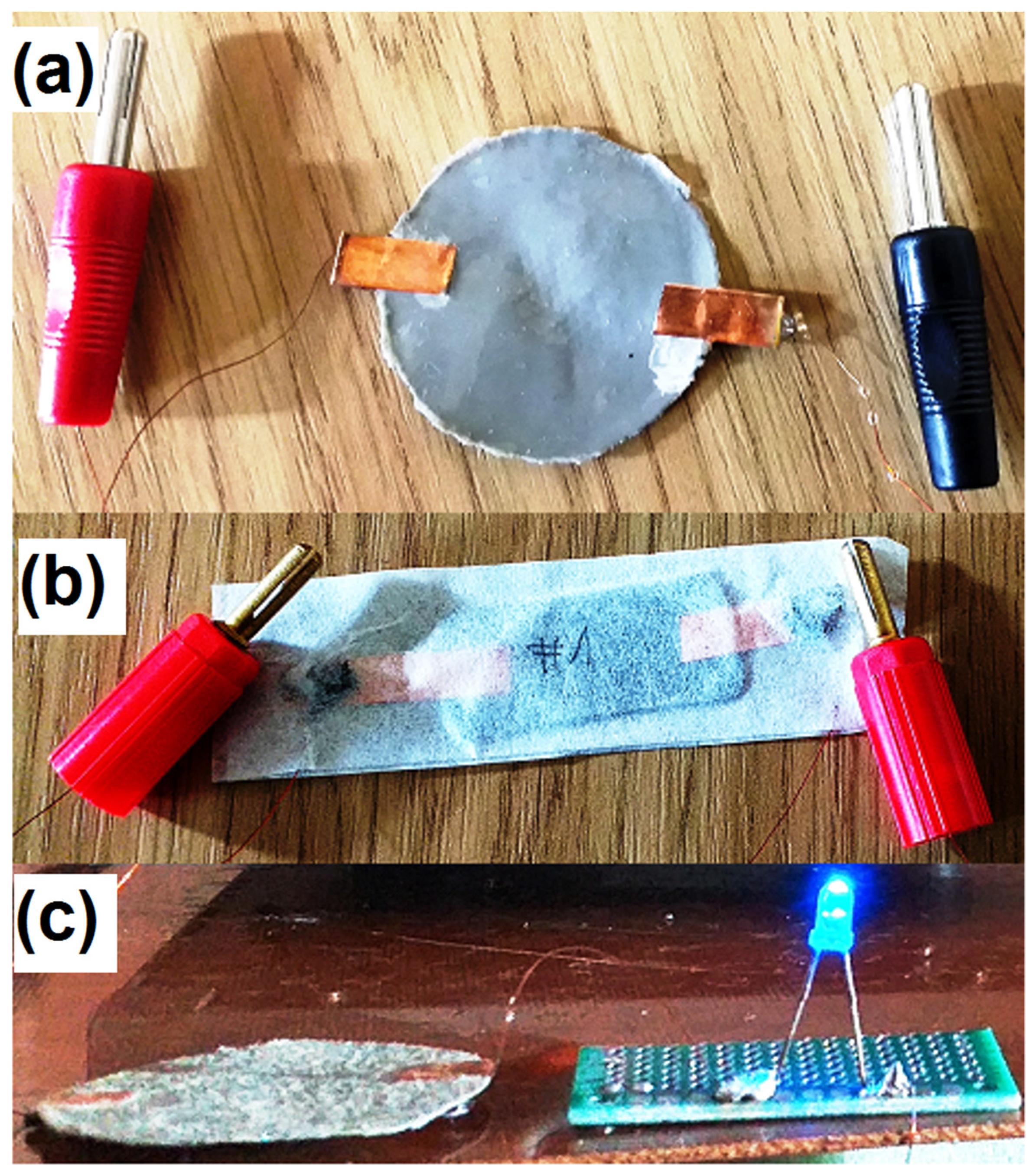

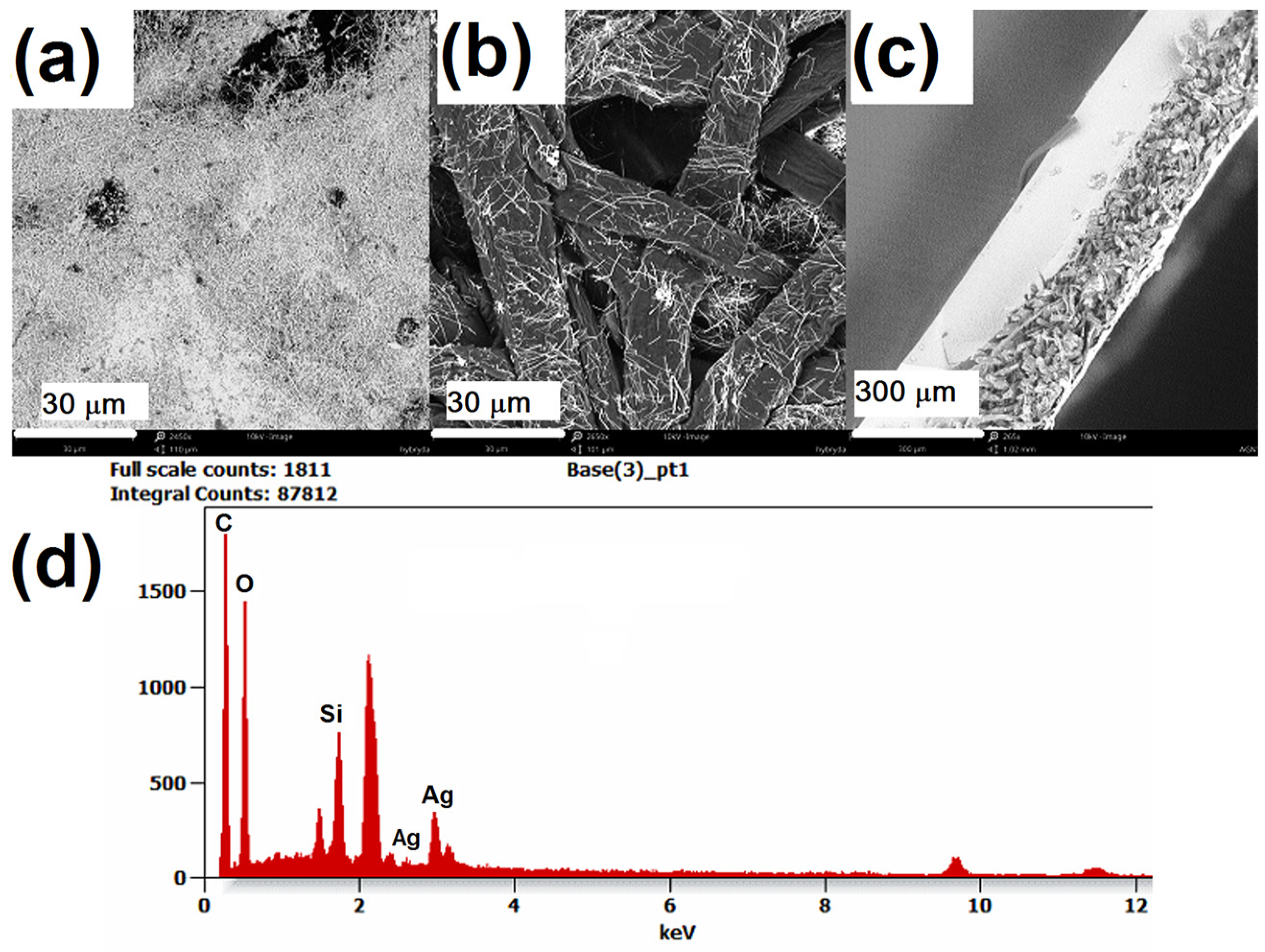
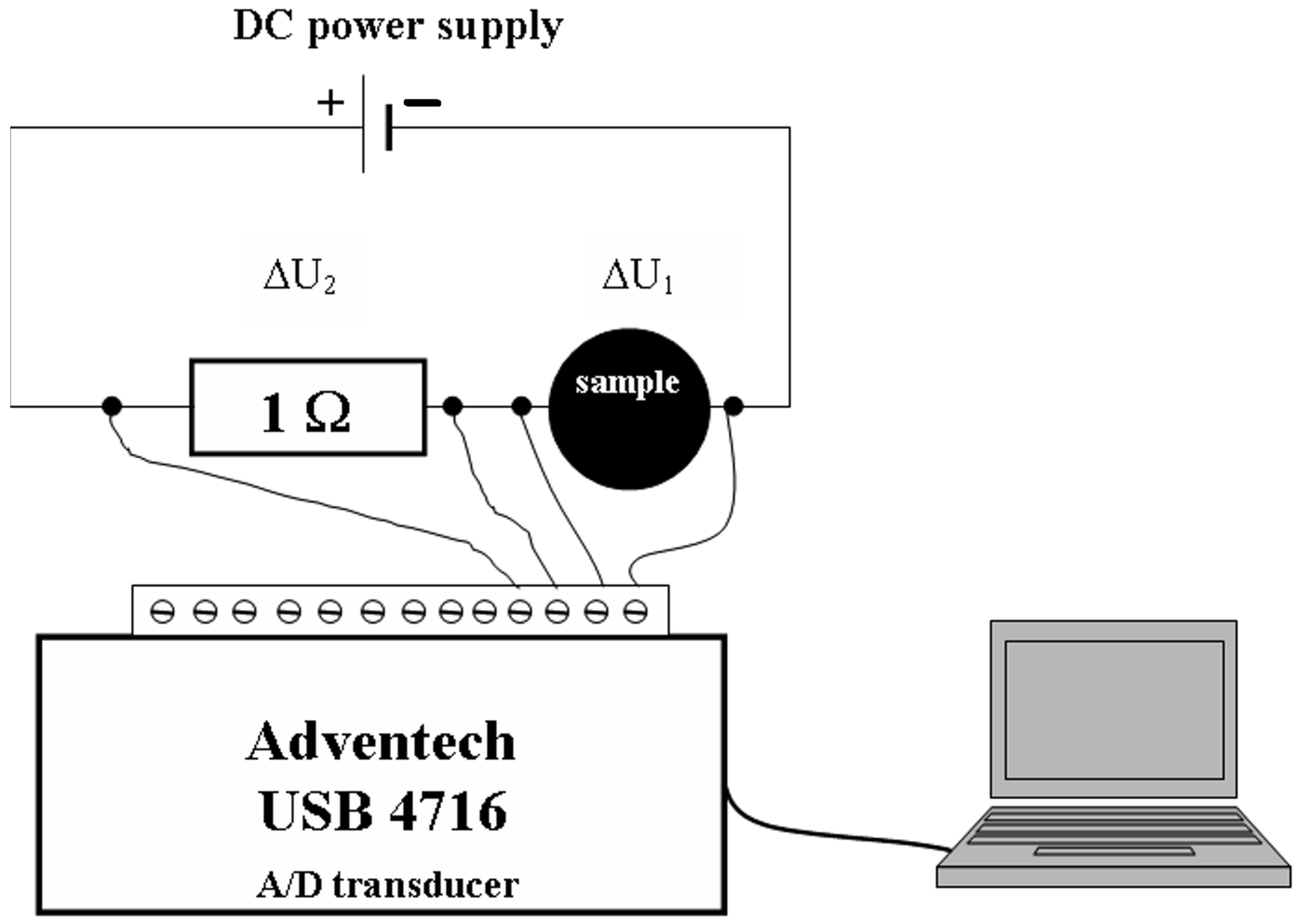

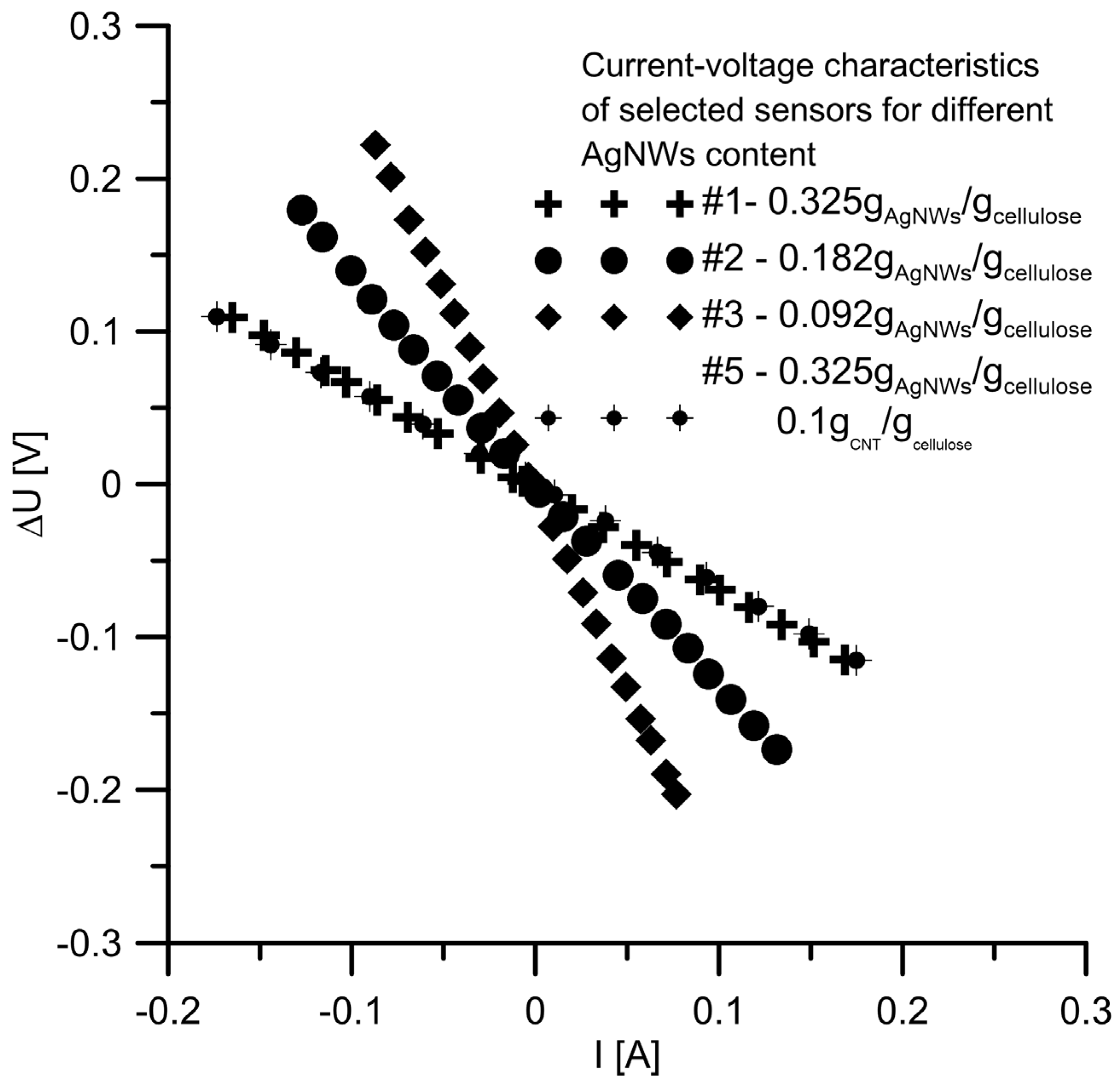

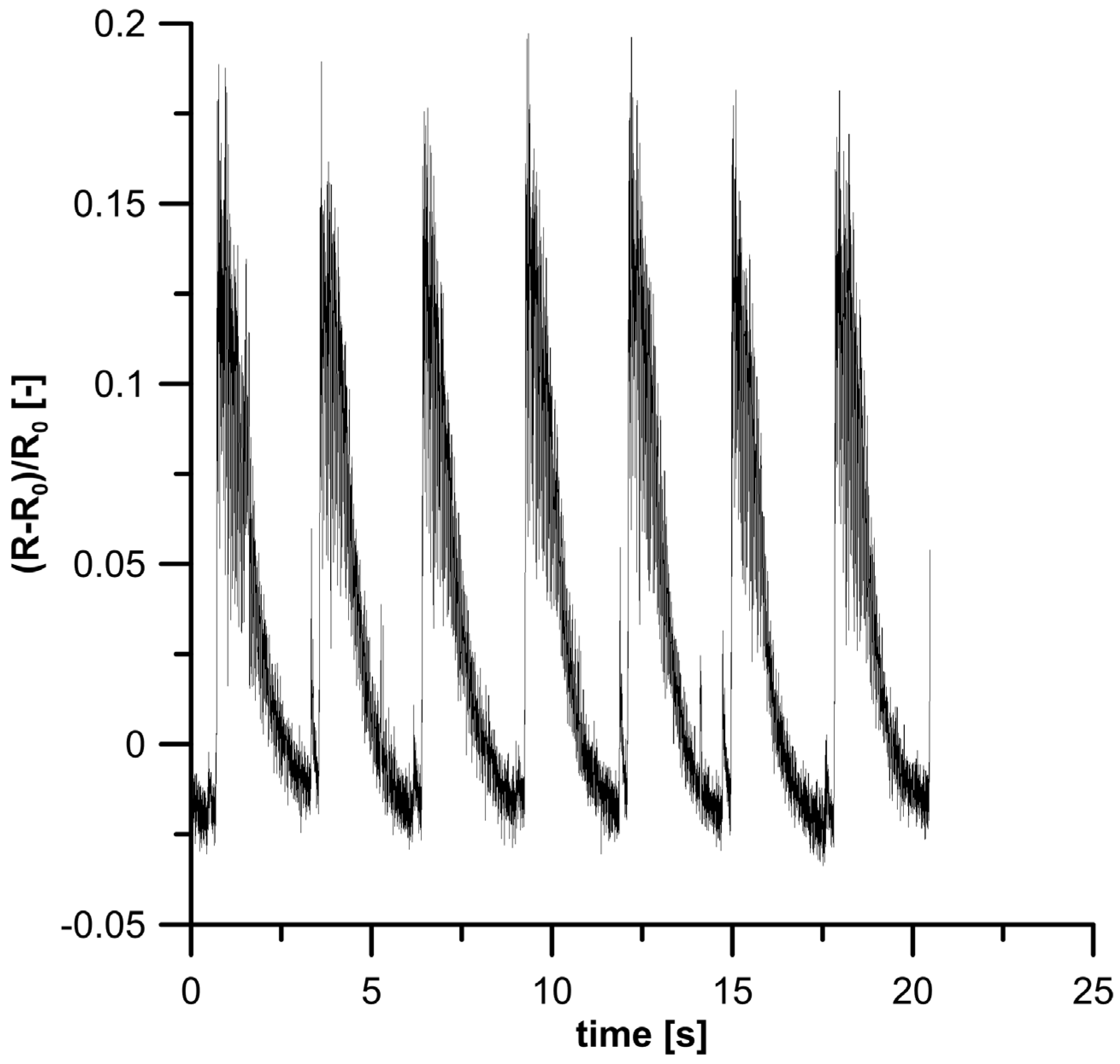
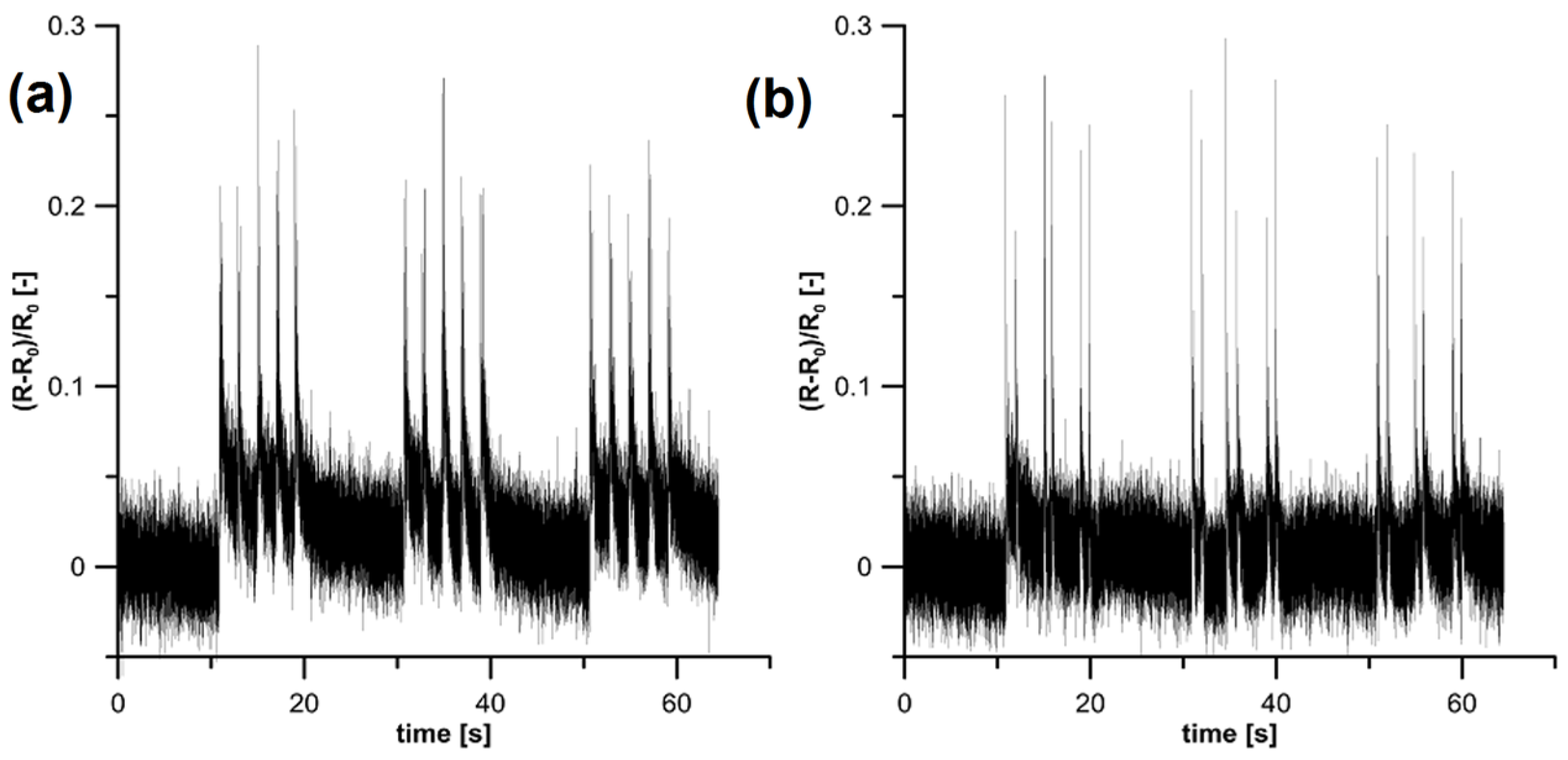


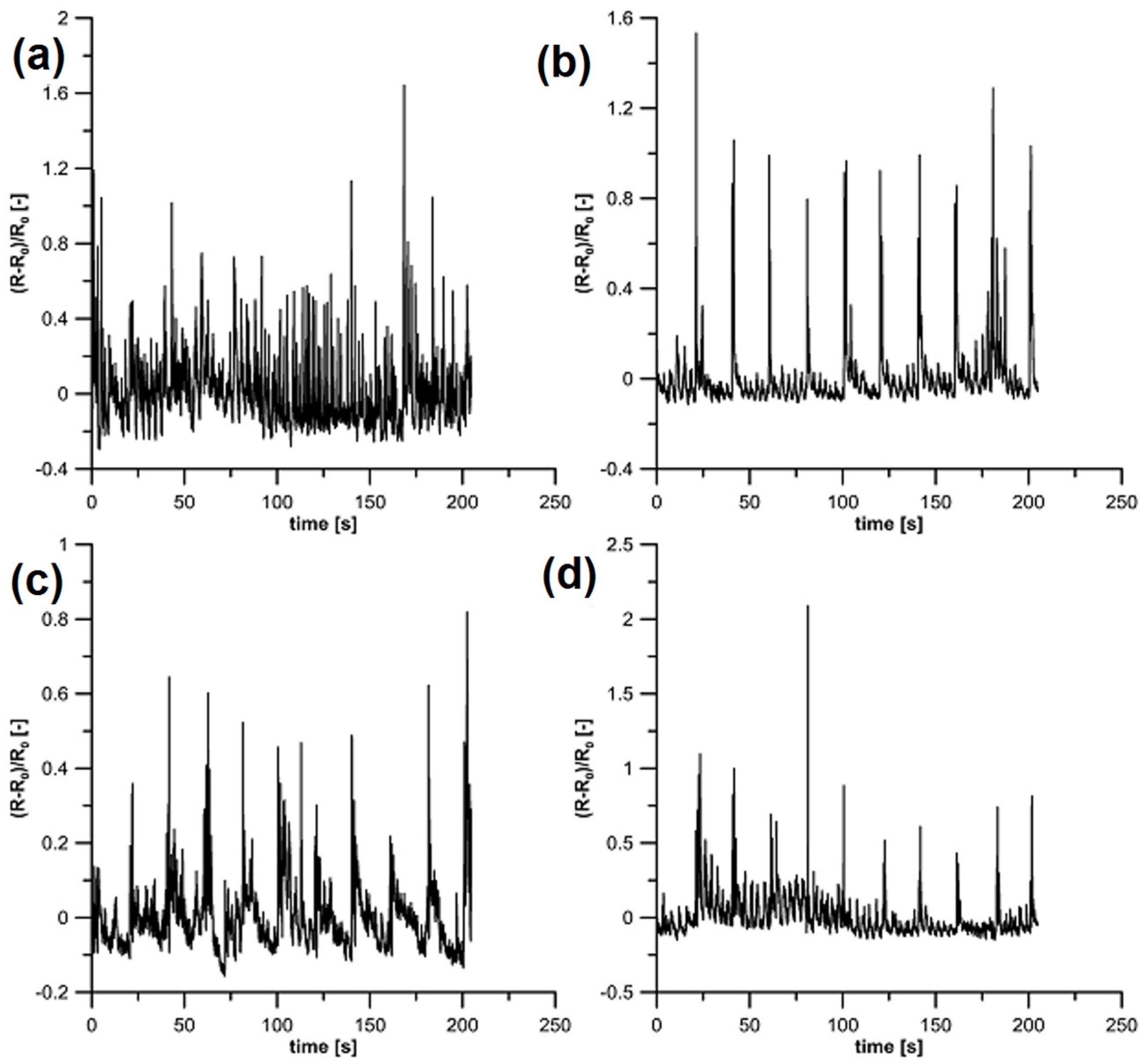
Disclaimer/Publisher’s Note: The statements, opinions and data contained in all publications are solely those of the individual author(s) and contributor(s) and not of MDPI and/or the editor(s). MDPI and/or the editor(s) disclaim responsibility for any injury to people or property resulting from any ideas, methods, instructions or products referred to in the content. |
© 2024 by the authors. Licensee MDPI, Basel, Switzerland. This article is an open access article distributed under the terms and conditions of the Creative Commons Attribution (CC BY) license (https://creativecommons.org/licenses/by/4.0/).
Share and Cite
Dzido, G.; Piotrowski, K.; Sakiewicz, P.; Gołombek, K.; Bańbuła, S.; Domagała, N.; Ratajczak, M.; Kunert, M.; Ignaszewska, A. Experimental Proof of Concept for Using Hybrid Paper Based on Silver Nanowires, Cellulose and Poly(dimethylsiloxane) in Systems Dynamic Analysis and Healthcare Applications. Appl. Sci. 2024, 14, 6783. https://doi.org/10.3390/app14156783
Dzido G, Piotrowski K, Sakiewicz P, Gołombek K, Bańbuła S, Domagała N, Ratajczak M, Kunert M, Ignaszewska A. Experimental Proof of Concept for Using Hybrid Paper Based on Silver Nanowires, Cellulose and Poly(dimethylsiloxane) in Systems Dynamic Analysis and Healthcare Applications. Applied Sciences. 2024; 14(15):6783. https://doi.org/10.3390/app14156783
Chicago/Turabian StyleDzido, Grzegorz, Krzysztof Piotrowski, Piotr Sakiewicz, Klaudiusz Gołombek, Sonia Bańbuła, Natalia Domagała, Martyna Ratajczak, Mateusz Kunert, and Agnieszka Ignaszewska. 2024. "Experimental Proof of Concept for Using Hybrid Paper Based on Silver Nanowires, Cellulose and Poly(dimethylsiloxane) in Systems Dynamic Analysis and Healthcare Applications" Applied Sciences 14, no. 15: 6783. https://doi.org/10.3390/app14156783




